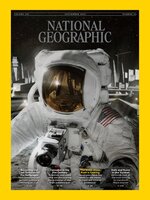Amazing discoveries and experiences await you in every issue of National Geographic magazine. The latest news in science, exploration, and culture will open your eyes to the world’s many wonders.
FROM THE EDITOR
CONTRIBUTORS
NATIONAL GEOGRAPHIC EXPLORERS • These contributors have received funding from the National Geographic Society, which is committed to illuminating and protecting the wonder of our world.
MAKING OF A MASTERPIECE • LOOKING AT THE EARTH FROM EVERY POSSIBLE ANGLE
THE BACKSTORY • A PHOTOGRAPHER CHRONICLES ‘SOMETHING SPECIAL’: THE COMPLEX EFFORT THAT BUILT A NEW SPACE OBSERVATORY.
Interview With a Rock Star Scientist • BRIAN MAY—CO-FOUNDER OF THE BAND QUEEN, CONSULTANT TO NASA—BLENDS ASTROPHYSICS AND ROCK MUSIC TO CREATE COSMIC HARMONY.
DESIGNING WOMAN • Sabrina Thompson is on a mission to empower women, starting with a flight suit that fits.
DISPATCHES FROM THE FRONT LINES OF SCIENCE AND INNOVATION
SOLAR POWER FROM SPACE • SCIENTISTS ARE HONING TOOLS THAT WOULD SEND THE SUN’S ENERGY TO EARTH AS RADIO SIGNALS.
Star creation, in miniature
A SOARING LIFE’S LEGACY • ARTIFACTS FROM SALLY RIDE’S CAREER AND PERSONAL LIFE BEAR WITNESS TO HER ROLE AS A PATHFINDER—IN SPACE AND BEYOND.
GAWKING AT ROCKETS • FROM COAST TO COAST, LIFTOFF FANS IN THE U.S. ARE MAKING PILGRIMAGES TO A HISTORIC NUMBER OF NEW ROCKET LAUNCHES.
ROCKET LAUNCH TOURISM
Welcome to the Cosmic Odyssey • WHEN TODAY’S EXPLORERS LOOK TO THE HEAVENS, THEY BECOME PART OF ‘A THRILLING, HUMBLING, AND THOROUGHLY ENTERTAINING JOURNEY OF DISCOVERY.’
When Innovation Is Extraterrestrial • THESE NATIONAL GEOGRAPHIC EXPLORERS ARE LOOKING INTO THE LIMITLESS FUTURE OF SPACE.
A NEW ERA OF DISCOVERY SPACE
UP + AWAY • NASA’S ARTEMIS PROGRAM BRINGS US ONE GIANT LEAP CLOSER TO THE MOON, MARS, AND BEYOND.
BACK TO THE MOON
GOING THE DISTANCE • On the Artemis I mission, the uncrewed Orion reached its maximum distance from Earth: 268,563 miles, a record for any round-trip mission with a spacecraft built to hold crew. Now, for Artemis II, the SLS must safely carry four humans on a similarly ambitious trajectory as they test its evolvable technology for future explorations, including human missions to the moon and Mars and robotic missions to the moon, Mars, Saturn, and Jupiter.
INTO THE SHADOWS
FOCUS • Machine learning is helping us bring mysterious black holes into sharper view.
TIME TRAVEL TO ANCIENT GALAXIES • THE MOST POWERFUL SPACE TELESCOPE EVER BUILT IS HUNTING FOR THE ORIGINS OF THE UNIVERSE.
DECODING THE DAWN • The universe’s hazy infancy, known as the dark ages, ended with the arrival of the first stars. Their light launched a process that broke up and cleared the cosmic fog, fueling a billion-year transformation of the universe into a host of galaxies, black holes, and other phenomena across our night sky.
THE FIRST STARS • A computer simulation depicts three primordial clouds—early star-forming regions—just 100 million years after the big bang, beyond what Webb can see.
THE FIRST GALAXIES
A GALAXY FROM THE DAWN OF TIME
THE EARLIEST BARRED SPIRAL GALAXIES
LIGHT • Vying for room at the edge of space, growing satellite traffic is crowding the skies.
THE ALIEN MOON SHOT • ASTROBIOLOGISTS ARE SEARCHING THE SOLAR SYSTEM’S ICY MOONS FOR LIFE. BUT FIRST, THEY MUST TEST THEIR TECHNIQUES HERE ON EARTH.
OCEANS BEYOND EARTH • Liquid water—warmed indirectly by gravitational forces—exists on several of the solar system’s moons. Some may even contain exponentially more water than exists on Earth. While liquid water is suspected on one of Neptune’s moons, the moons of Jupiter and Saturn are closer and easier to visit....

 Jan 01 2026
Jan 01 2026
 Dec 01 2025
Dec 01 2025
 Nov 01 2025
Nov 01 2025
 Oct 01 2025
Oct 01 2025
 Sep 01 2025
Sep 01 2025
 Aug 01 2025
Aug 01 2025
 Jul 01 2025
Jul 01 2025
 Jun 01 2025
Jun 01 2025
 May 01 2025
May 01 2025
 Apr 01 2025
Apr 01 2025
 Mar 01 2025
Mar 01 2025
 Feb 01 2025
Feb 01 2025
 Jan 01 2025
Jan 01 2025
 Dec 01 2024
Dec 01 2024
 Nov 01 2024
Nov 01 2024
 Oct 01 2024
Oct 01 2024
 Sep 01 2024
Sep 01 2024
 Aug 01 2024
Aug 01 2024
 Jul 01 2024
Jul 01 2024
 Jun 01 2024
Jun 01 2024
 May 01 2024
May 01 2024
 Apr 01 2024
Apr 01 2024
 Mar 01 2024
Mar 01 2024
 Feb 01 2024
Feb 01 2024